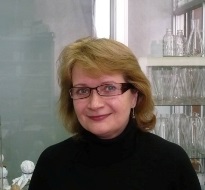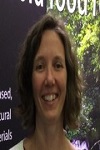Day 2 :
Keynote Forum
Marina Donova
Russian Academy of Sciences, Russia
Keynote: Phytosterol bioconversions by Actinobacteria and their application in steroid pharmaceutical industry
Time : 10:00-10:30 am

Biography:
Marina Donova has completed her PhD at 1992, and has got a degree of Doctor of Sciences (Biology) in 2006 at the Institute of Biochemistry and Physiology of Microorganisms, Russian Academy of Sciences (IBPM RAS). Since 1998, she is a Head of Laboratory MTOC at IBPM RAS. The interests of Dr. Donova cover all aspects of steroid conversions by microorganisms including discovery of novel biocatalysts, investigation of metabolic pathways, the development and scaling up of the biotechnologies. The competence and qualification of Dr.Donova is confirmed by over 70 peer reviewed papers, one monograph and over 10 RF patents.
Abstract:
Phytosterols represent available and low-cost raw materials for steroid pharmaceutical industry. Bioconversion of phytosterols using selected wild-type and recombinant strains of actinobacteria is an effective way to produce high-valued steroidal drugs and their precursors. Although considerable progress was achieved during last decade in the development of biotechnologies for production of key intermediates from phytosterol, the important task is selection of suitable microorganisms, as well as creation of engineered strains to provide improved bioprocesses and to generate novel products. rnRecently, whole genome sequencing of several sterol-transforming actinobacteria strains was carried out and the phytosterol catabolism associated genes were revealed related to steroid import across the cell wall, side-chain degradation and steroid core degradation, as well as to other key steroid modifications. The features of the genomes clarified the capability of the strains to accumulate different androstanes as major products from phytosterol. The transcriptomic studies provided more clear understanding of the role of candidate genes in steroid modifications by the strains. The significance of the findings for creating of effective microbial catalysts for phytosterol conversion is highlighted.rnThe novel data on the production methods of androstenedione (AD), 1-dehydro-AD (ADD), 9α-hydroxy-AD, 11α-hydroxy-AD, 9(11)-dehydro-AD, dehydroepiandrosterone, testosterone, 1-dehydrotestosterone, as well as progesterone and 20-hydroxymethylpregnanes from phytosterol using selected and engineered actinobacteria are presented. rnThe challenges and prospects of phytosterol conversion by actinobacteria are discussed.rn
- Track 2 : Microbes: Fermentation Processes
Track 3: Microbes: Food and Agriculture
Track 6 : Parameter of Microbial Growth

Co-Chair
Zhigang (Peter) Zhou
Chinese Academy of Agricultural Sciences, China
Session Introduction
Alexander Sulakvelidze
Intralytix, USA
Title: Bacteriophages - new class of beneficial microbes and their practical applications

Biography:
Dr. Alexander Sulakvelidze, Ph.D. is Chief Scientist of Intralytix, and an internationally recognized expert in phage technology. Dr. Sulakvelidze has published extensively on the subject of phage therapy, including co-editing a major book about bacteriophages in 2005. He is the author of several issued and pending patents in the field of phage therapy. Dr. Sulakvelidze is currently serving as Editor-in-Chief of the journal Bacteriophage, and as an ad hoc reviewer for several other journals and funding agencies.
Abstract:
Probiotics offer the promise of health benefits by altering the commensal gut microbiota, and they continue to gain in popularity. However, one approach for a “probiotic intervention” that has not received much prior attention is to use lytic bacteriophages (or phages) to target specific pathogenic bacteria in the gastrointestinal (GI) tract, oral cavity, skin, etc. before they can cause disease. Lytic phages are bacterial viruses that attach to and kill their bacterial hosts by lysing them during their internal replication cycle. Bacteriophages are arguably the oldest (ca. 3.5 billion-years-old) and most ubiquitous organisms (1030-1032 phage particles) on Earth, and they have remarkable bactericidal activity against their specific bacterial hosts; i.e., phages attack their targeted bacterial hosts but cannot infect human or other eukaryotic cells. The approach of using lytic phages as part of a probiotic diet is similar to that used for bacteria-based probiotics, which are administered during a period of time and act by favorably conditioning the gut, mouth, skin, etc. microflora. The key difference between bacteria-based probiotics and lytic phage-based probiotics (designated “phage-biotics”) is that the former introduce nonpathogenic bacteria into the mammalian organism (in order to interfere with the ability of pathogenic bacteria to colonize and cause disease); whereas, the latter use lytic phage to kill specific pathogenic bacteria. Thus, bacteriophages represent a new class of beneficial microbes that may have a wide-range of practical applications in human and veterinary medicine, food safety, cosmetics, and other areas. The presentation will give the audience a current perspective about the history of bacteriophage therapy research and the crucial regulatory and human safety issues concerning the use of bacteriophages as phage-biotics. Phage-based probiotics are expected to have, because of their high specific activity, a very gentle effect on the overall microflora, which may further enhance their protective effects. They are also expected to be compatible – and, in fact, synergistic – with all classical bacteria-based probiotics. Thus, the phage-based probiotic approach may serve as a platform technology for developing a new class of super-probiotics for managing bacterial infections. Moreover, phage-biotics may be valuable tools for advancing our understanding of the important physiological roles that some normal flora bacteria have in the mammalian organism. That knowledge may help to identify new strategies for improving human health in areas not involving the prevention and treatment of bacterial diseases; e.g., reducing the occurrence of obesity and some forms of cancer, where the GI tract’s normal microbiota may have a role.

Biography:
Joelle Woolston is a research scientist and laboratory manager at Intralytix, where she provides hands-on research, directs and supervises laboratory staff, and assists in the regulatory approval process. Prior to joining Intralytix, she worked on metabolic transporters at the Childrens’ Hospital in Washington, D.C. and co-developed a patented phage-based vector system at the University of Maryland.
Abstract:
The use of bacteriophages as biocontrol agents is an environmentally friendly, all-natural method to eliminate or significantly reduce contamination of food by pathogenic bacteria. Bacteriophages, arguably the oldest and most ubiquitous organisms on Earth, are viruses that kill bacteria. They play a key role in maintaining the microbial balance in any ecosystem where bacteria exist and are part of the normal microflora of all fresh, unprocessed foods. Interest in bacteriophages has been gaining momentum in recent years, as reflected in the both the number of regulatory approvals for bacteriophage products and the number of published studies. Because of the specificity of bacteriophages, their application only affects the target bacteria (the pathogen) but will not affect the other naturally present and potentially beneficial microflora. Bacteriophage products that target Listeria monocytogenes, Salmonella, and E. coli have been shown to reduce or completely eliminate the specific pathogen on a variety of foods, including beef, chicken, seafood, fruits and vegetables, and dairy products. In the US, several have been cleared as GRAS, with others receiving FCN and FAP approvals. Furthermore, none of the phage preparations affect the treated foods’ flavors, aromas, or appearances. The presentation will review information about the use of bacteriophages in foods and food processing settings, as well as discuss regulatory and safety issues concerning the use of bacteriophages in the food industry
Andrey Aleshkin
Gabrichevsky Moscow Research Institute for Epidemiology and Microbiology, Russia
Title: Phagebiotics in treatment and prophylaxis of foodborne infections

Biography:
Andrey Aleshkin, Sc.D.-biology, now is head of the Laboratory for Clinical Microbiology and Biotechnology of Bacteriophages of Gabrichevsky Moscow Research Institute of Epidemiology and Microbiology (MRIEM) and chief scientist in Bphage LLC. He received his Ph.D.-medicine in medical cybernetics at Pirogov Russian National Medical University, MBA in marketing at Lomonosov Moscow State University, Sc.D. in biotechnology and microbiology at Gabrichevsky MRIEM. Currently Dr. Andrey Aleshkin’s research focuses on the clinical safety and specific activity of bacteriophages as probiotics and decontaminating agents for food products. He has published more than 60 papers in peer-reviewed journals and 30 patents in Russia.
Abstract:
The more prevalent bacterial strains increasing in numbers are those with high thermostability, resistant to many present-day antibiotics and disinfectants, those which are capable to cause foodborne infections (FBI) with high mortality incidence among patients. In this situation using the accumulated Russian experience it is logical to propose a worldwide development of a renewed class of antibacterial agents based on bacteriophages. Since 1930s in different parts of the Soviet Union a lot of doctors began to use phages in human prophylaxis and therapy. Later in the 1960s four Institutes for Vaccines and Sera (in Ufa, Tbilisi, Nizhnii Novgorod, and Perm’) began to produce a dozen medicinal compounds based on several individual species of bacteriophages or their combinations which were used to treat and prevent acute intestinal infections and decompensated forms of dysbacteriosis and to control causative agents of certain pyoinflammatory infections. In recent years in the Russian Federation phage cocktails are administered intracorporeally or locally: wound and mucosa irrigation, introduction in the cavities of vagina, urinary bladder, ear, paranasal sinus, eye conjuctiva and also in the drained cavities: abdominal, and pleural, in the cavities of abscesses after the pus was removed. Therefore, world scientists should not neglect these clinical results when designing any future studies. We have developed a phagebiotic for prophylaxis of FBI caused by E.coli, Shigella flexneri, Shigella sonnei, Salmonella enterica, Listeria monocytogenes or Staphylococcus aureus, and investigated its effectiveness against infection caused by the non-pathogenic Lac (-) strain of E.coli in animal and human trials
Lawrence Goodridge
McGill University, Montreal, Quebec, Canada
Title: Reprogramming the gut: Bacteriophages and their roles in modifying the gastrointestinal microflora

Biography:
Dr. Lawrence Goodridge is a native of Hamilton, Ontario, Canada, and received his Ph.D. from the University of Guelph (pronounced Gwelf) in Guelph, Ontario, Canada with a major emphasis in Food Microbiology and Food Safety in 2002. Currently, Dr. Goodridge is the Ian and Jayne Munro Chair in Food Safety at McGill University. Dr. Goodridge’s primary research interest is the use of bacteriophages to study and solve problems associated with the production of food. He has published more than 55 peer reviewed publications and book chapters on topics related to food safety.
Abstract:
While it has long been understood that microorganisms in the human gut play an important role in digestive health, more recent research indicates that gut bacteria may relate to wider aspects of health, including obesity and metabolic health. The role that bacteriophages play in modulating the gut microflora and potentially the systemic health of animals (including humans) is increasing being recongized. The animal gastrointestinal tract (GIT) contains 1015 bacteriophages, which are collectively referred to as the phageome. Individual phageomes vary depending on age and health, thus providing a useful biomarker of animal health as well as suggesting potential interventions that could be targeted at the gut microbiota. Additionally, recent research has shed light on the how the phageome actively modulates the microflora as well as the survival, and thus efficacy of probiotic bacteria within the animal GIT. For example, phages that are unique to individual bacterial isolates have been shown to act as a predator, infecting and killing similar, competing bacterial strains, providing a competitive advantage to the bacteria harbouring the phage, by decreasing competition for available nutirents in the GIT. In this way, phages are expected to have a significant role in driving the biodiversity of the complex ecosystem of the animal GIT. Further exploration is neccesary in order to harness the enormous potential of the phageome to reprogram the microflora of the GIT, either to prevent diseases from occurring or in response to an active disease.
Alejandro Pérez-de-Luque
University of Sheffield, United kingdom
Title: Belowground interactions between mycorrhiza and rhizobacteria prime above ground wheat defence

Biography:
Alejandro Pérez-de-Luque is a plant researcher and agronomist, interested in resistance of plants against phytopathogens (parasitic plants, fungi, etc.). He started his career back in 1994, during the universitary studies, as undergraduate assistant in the Department of Biochemistry and Molecular Biology at the University of Córdoba (Spain). After getting the degree in Agronomical Engineering, he received a grant for PhD studies in the Department of Genetic at the University of Córdoba. He has been working in different institutes and researching centers in Spain, UK and Israel, and has been awarded contracts from the \\\\\\\'Juan de la Cierva\\\\\\\' and \\\\\\\'Ramon y Cajal\\\\\\\' Spanish post-doc programmes. He is a permanent researcher in the Department of Plant Breeding and Biotechnology at the IFAPA since 2009, and he held a two years Marie Curie Intra-European Fellowship at the University of Sheffield
Abstract:
Plant breeding for resistance genes and chemical treatments are currently the main strategies to control plant diseases. However, withdrawal of agrochemicals under new EU legislation and co--â€evolution of diseases to overcome crop resistance genes have increased the need to find alternative means to improve crop disease management. Disease suppression by root colonizing non--â€pathogenic microorganisms has been Recognized as a promising long--â€term strategy. Beneficial rhizosphere--â€colonizing microorganisms, such as arbuscular mycorrhiza fungi (AMF) and plant growth--â€promoting rhizobacteria (PGPR), can prime the plant immune system against pathogen attack (Cameron et al., 2013). However, the complexity of the plant root microbiome has hampered wide--â€ranging exploitation of these biocontrol organisms in current crop protection schemes. In this work, we have evaluated the interaction between two beneficial microorganisms, a mycorrhizal fungus (Glomus intraradices) and a plant growth promoting rhizobacterial strain (Pseudomonas putida) and investigated the mechanisms by which these microbes synergistically prime wheat (Triticum aestivum) for enhanced defensive responses.
Stéphane Duboux
Nestlé Research Center, Lausanne, Switzerland
Title: The Key to Acetate: Metabolic Fluxes of Acetic Acid Bacteria under Cocoa Pulp Fermentation-Simulation Conditions
Biography:
Stéphane Duboux is currently working in Nestlé Research Center, Lausanne, Switzerland. He has published various papers in various journals
Abstract:
Chocolate preprocessing involves pod opening, bean (pulp) fermentation, and bean drying, followed by roasting of the cocoa beans (1). Cocoa bean fermentation is a spontaneous process that is carried out under rather uncontrolled conditions. Thus, the result of the fermentation process strongly depends on the microbial population of the pulp and postharvest practices on the farm (2). Acetic acid bacteria (AAB) play an important role during cocoa fermentation, as their main product, acetate, is a major driver for the development of the desired cocoa flavors (3, 4). Here, we investigated the specialized metabolism of these bacteria under cocoa pulp fermentation-simulating conditions via carefully designed combination of parallel 13C isotope labeling experiments. The received insights supported the first development of experimental starter cultures.
Marta Dudkiewicz
Lodz University of Technology, Poland
Title: Amino-acid profiles of Yeast Autolysates
Biography:
Marta Dudkiewicz has graduated from Lodz University of Technology (LUT) with BSc in Technical Microbiology and MSc in Fermentation Technology. The subject of her MSc thesis, which she completed in 2014, was “The utilization of sugar beet pulp hydrolysate for lactic acid fermentation”. Currently, she is employed by Institute of Fermentation Technology and Microbiology (LUT), working as a scientist and researcher and doing research for Applied Research Programme – Project PBS1/B8/3/2012. She is a co-author of several articles which are going to be published soon.
Abstract:
The interest in the production of yeast extracts and their use as food additives has been growing in the recent years. Yeast extracts can be obtained from pure culture or from post – fermentation cultures. Free amino acids in the extracts are known to have a major influence on flavor. Yeast hydrolysates with higher concentrations of valine, leucine, threonine and phenylalanine, as well as of sulfur amino acids (cysteine and methionine), could enhance flavor. This work presents the results of a study to determine the effect of Quillaja saponaria saponins on the autolysis of industrial yeast strains. Saponin is a relatively unconventional inductor for yeast autolysis. Cells treated with saponin retain sufficient integrity for rapid equilibration. The proposed method also has the advantages of relatively low cost, low added salt and well-documented health benefits. The distillery yeasts (Saccharomyces cerevisiae (Lesaffre) and Kluyveromyces marxianus LOCK0026) were used as pure cultures in the study, as well as post-fermentation mixed cultures. Cell suspension density was estimated using a Muse® Cell Analyzer. The concentration of proteins was measured using Direct Detect® system. Free amino nitrogen concentration (FAN) was determined based on the colour reaction with ninhydrin. The concentration of ammonia nitrogen was measured colorimetrically with Nessler’s reagent. Free amino acids in the autolysates was measured using the Pico-Tag method. The presence of saponin during autolysis resulted in a substantial increase in the concentration of nitrogen compounds, in comparison to tests without this agent. Post-fermentation biomass had more interesting amino – acid profile than aerobically propagated monocultures.
Marina Donova
Russian Academy of Sciences, Russia
Title: Phytosterol Bioconversions by Actinobacteria and Their Application in Steroid Pharmaceutical Industry

Biography:
Marina Donova has completed her PhD at 1992, and has got a degree of Doctor of Sciences (Biology) in 2006 at the Institute of Biochemistry and Physiology of Microorganisms, Russian Academy of Sciences (IBPM RAS). Since 1998, she is a Head of Laboratory MTOC at IBPM RAS. The interests of Dr. Donova cover all aspects of steroid conversions by microorganisms including discovery of novel biocatalysts, investigation of metabolic pathways, the development and scaling up of the biotechnologies. The competence and qualification of Dr.Donova is confirmed by over 70 peer reviewed papers, one monograph and over 10 RF patents.
Abstract:
Phytosterols represent available and low-cost raw materials for steroid pharmaceutical industry. Bioconversion of phytosterols using selected wild-type and recombinant strains of actinobacteria is an effective way to produce high-valued steroidal drugs and their precursors. Although considerable progress was achieved during last decade in the development of biotechnologies for production of key intermediates from phytosterol, the important task is selection of suitable microorganisms, as well as creation of engineered strains to provide improved bioprocesses and to generate novel products. Recently, whole genome sequencing of several sterol-transforming actinobacteria strains was carried out and the phytosterol catabolism associated genes were revealed related to steroid import across the cell wall, side-chain degradation and steroid core degradation, as well as to other key steroid modifications. The features of the genomes clarified the capability of the strains to accumulate different androstanes as major products from phytosterol. The transcriptomic studies provided more clear understanding of the role of candidate genes in steroid modifications by the strains. The significance of the findings for creating of effective microbial catalysts for phytosterol conversion is highlighted. The novel data on the production methods of androstenedione (AD), 1-dehydro-AD (ADD), 9α-hydroxy-AD, 11α-hydroxy-AD, 9(11)-dehydro-AD, dehydroepiandrosterone, testosterone, 1-dehydrotestosterone, as well as progesterone and 20-hydroxymethylpregnanes from phytosterol using selected and engineered actinobacteria are presented. The challenges and prospects of phytosterol conversion by actinobacteria are discussed.
Françoise Leroi
Ifremer, France
Title: Use of bioprotective bacteria to guaranty quality and safety of seafood products

Biography:
Dr Françoise Leroi is the head of the laboratory Microbial Ecosystems and Marine Molecules for Biotechnology (EM3B) at Ifremer (Nantes, France). Since 1994, she has been working on quality and safety of seafood products, microbial ecology, identification of spoiling microorganisms, microbial growth modelling and impact of processes. She has been working on biopreservation of seafood for more than 20 years. She is member of the National Technological Network on Bioprotective Cultures created in France in 2009. She is project leader of many national and European projects. She has published more than 45 papers in reputed journals and has been serving as an editorial board member of the Journal of Aquatic Food Product Technology.
Abstract:
Around 10 to 20% of all outbreaks are attributed to seafood. For indigenous bacteria (Clostridium botulinum, Vibrio spp., Aeromonas, Listeria monocytogenes, histamine-producing bacteria…), the hazard concern (i) fresh or lightly preserved products in which the growth of those bacteria is possible and which are eaten raw or insufficiently cooked ; (ii) Scombroid and Clupeid fish stored at abuse temperature ; (iii) shellfish which concentrate the bacteria and virus during their filter feeding. Other micro-organisms such as Salmonella, Shigella, Echerichia coli, Staphylococcus aureus… can be introduced in the aquatic environment or during post harvest handling and processing. Beside this short review, the biopreservation technology will be presented. Biopreservation is a method of preserving food using microorganisms, which are thus called protective cultures (PCs). This technology consists of inoculating a food with a non-pathogenic microorganism, selected to prevent the development of other undesirable microbes and thus guaranty its safety and quality. LAB are good candidates for biopreservation because (i) they have many natural antibacterial properties (ii) they are part of the common flora of many foods; (iii) they are recognized as non-hazardous to human health; (iv) they benefit from a healthy image conveyed to consumers by dairy products. This talk will present the strategy of protective culture selection, the mechanisms of action, the regulation context and examples of application in seafood, especially for prevention of risk associated to spoiling bacteria, histamine-producing bacteria and L. monocytogenes.
Imane Wahby
MAScIR, Morocco
Title: Microalgae for industrial applications: from laboratory to industry

Biography:
Imane Wahby has completed his PhD at the age of 28 years from Granada University and postdoctoral studies from CSIC. She is the director of Green Biotechnology Center in MAScIR (Morocco) working on the valorization of natural resources. She has 4 papers published and 8 patents related to the industrial application of microalgae. She led more than 10 projects for industrial application of microorganisms mainly in the field of agriculture, alimentation and cosmetic.
Abstract:
Microalgae represent an emerging biological resource of great importance for its potential applications in different fields, in particular as a new source of valuable nutrients and biologically active molecules. MAScIR works since 2010 on a global project for microalgae valorization and developed a microalgae collection fully characterized (lipids, FAMEs profile, proteins, biological activities, etc.). Four projects are ongoing to develop products for agriculture and ingredients for neutraceutic and cosmetic use. Indeed microalgae with high content of amino acids, nitrogen, phosphorus and phytohormons was used to formulate a liquid product used as biofertiliser/growth booster developed with an industrial partner operating in biological agriculture. Other microalgae, mainly belonging to Arthrospira and Isochrysis genius, showed highest polysaccharides content and are used to formulate anti-stress products for agriculture. Developed formula allowed plants growth in highly saline soil and increased plant immunity against some bacterial and fungal disease (Botrytis and Clavibacter). For neutraceutical application, some microalgae showed high content of PUFA, iron and proteins (70% DW) and are used to develop a new formula containing high PUFA content coupled with two active extracts, actually in pre-commercial phase. Development of pharmaceutical ingredients from microalgae for cosmetic application is also targeted, a newly developed formula showed an anti-acne activity combining: bacteriostatic effect against the two bacteria responsible of the acne: Propionibacterium acnes and Staphylococcus epidermidis, anti-inflammatory and antioxydant effect and skin cell regenerative effect for an integral treatment of the acne. The bridge between R&D and industrial scale will be discussed for each project.
Osama Sam Ibhrahim
Consultant Biotechnology/ Food safety Bio Innovation U.S.A
Title: Expression of shiga-like toxin fused to vascular endothelial growth factor in Escherichia .coli for target angiogenesis

Biography:
Dr. Osama Ibrahim is a highly-experienced Principal Research Scientist with particular expertise in the field of microbiology, molecular biology, food safety, and bioprocessing for both pharmaceutical and food ingredients. He is knowledgeable in microbial screening /culture improvement; molecular biology and fermentation research for antibiotics, enzymes, therapeutic proteins, organic acids and food flavors; Biochemistry for metabolic pathways and enzymes kinetics, enzymes immobilization, bioconversion, and Analytical Biochemistry. Dr. Ibrahim was external research liaison for Kraft Foods with Universities for research projects related to molecular biology and microbial screening and holds three bioprocessing patents. In January 2005, he accepted an early retirement offer from Kraft Foods and in the same year he formed his own biotechnology company providing technical and marketing consultation for new startup biotechnology and food companies. Dr. Ibrahim received his B.S. in Agricultural Biochemistry with honor and two M.S. degrees in Microbial physiology/ Fermentation and in Applied Microbiology. He received his Ph.D in Basic Medical Science (Microbiology, Immunology and Molecular biology) from New York Medical College. His research dissertation was on the construction of plasmid for the expression of a fusion protein of VEGF121/ Shiga-like toxin as a therapeutic protein for targeting angiogenesis. He is a member of American Chemical Society, American Society of Microbiology, and Society of Industrial Microbiology since 1979
Abstract:
Angiogenesis is a highly controlled process of growing new blood vessels. Under normal circumstances angiogenesis occurs only during embryonic development, wound healing and development of the corpus luteum. However, in a large number of pathologies, such as solid tumor growth, various eye diseases and chronic inflammation states, angiogenesis is a crucial component of the disease process. Therefore, inhibitors of angiogenesis are being investigated as potential therapeutics for these pathologies. During angiogenesis endothelial cells of existing blood vessels undergo a complex process of reshaping, migration, growth, and organizing into new vessels. Vascular endothelial growth factor (VEGF) is a central mediator of this process and acts via receptors whose expression is restricted almost exclusively to endothelial cells. Because of its selectivity, VEGF represents a unique vehicle for delivery of inhibitors of angiogenesis to endothelial cells. Among potential inhibitors of angiogenesis, the shiga-like toxin-1 (SLT-I) produced by E.coli O157:H7 has the advantage that endothelial cells appear to be particularly sensitive to its action. Combining an SLT-I toxin with VEGF as a delivery vehicle would serve as a highly selective and active inhibitor of angiogenesis. Plasmids encoding the fusion proteins VEGF121 /A1 containing the catalytically active fragment of the SLT-I A subunit and VEGF121/A containing the full length A subunit of SLT-I were constructed in pET-29a and pET-32a systems. Escherichia coli BL21 (DE3) pLysS bacteria were transformed with the plasmid constructs and expressed fusion proteins were recovered in inclusion bodies upon induction with isopropyl –B-D-thiogalactopyranoside (IPTG). Both purified fusion proteins inhibited the translation of luciferase mRNA as a reporter gene in vitro translation system, indicating that both fusion proteins retain the N-glycosidase activity of SLT-I. However, only VEGF121/A1 fusion proteins displayed the ability to induce auto-phosphorylation of the VEGF receptor KDR/FLK-1.. In a biological assay VEGF121/A1 fusion proteins displayed a strong, selective growth inhibition of cultured cells expressing KDR/FLK-1 receptors. In summary, these results indicate that VEGF/SLT fusion proteins are promising therapeutic agents that can be developed into powerful and selective inhibitors of angiogenesis.
Osama Sam Ibhrahim
Consultant Biotechnology/ Food safety Bio Innovation U.S.A
Title: The nature of prebiotics and the impact of prebiotics/probiotics on gut health

Biography:
Dr. Osama Ibrahim is a highly-experienced Principal Research Scientist with particular expertise in the field of microbiology, molecular biology, food safety, and bioprocessing for both pharmaceutical and food ingredients. He is knowledgeable in microbial screening /culture improvement; molecular biology and fermentation research for antibiotics, enzymes, therapeutic proteins, organic acids and food flavors; Biochemistry for metabolic pathways and enzymes kinetics, enzymes immobilization, bioconversion, and Analytical Biochemistry. Dr. Ibrahim was external research liaison for Kraft Foods with Universities for research projects related to molecular biology and microbial screening and holds three bioprocessing patents. In January 2005, he accepted an early retirement offer from Kraft Foods and in the same year he formed his own biotechnology company providing technical and marketing consultation for new startup biotechnology and food companies. Dr. Ibrahim received his B.S. in Agricultural Biochemistry with honor and two M.S. degrees in Microbial physiology/ Fermentation and in Applied Microbiology. He received his Ph.D in Basic Medical Science (Microbiology, Immunology and Molecular biology) from New York Medical College. His research dissertation was on the construction of plasmid for the expression of a fusion protein of VEGF121/ Shiga-like toxin as a therapeutic protein for targeting angiogenesis. He is a member of American Chemical Society, American Society of Microbiology, and Society of Industrial Microbiology since 1979
Abstract:
Prebiotics are the fermentable, non-digestible carbohydrates that stimulate as nutrients the growth and the activity of beneficial bacteria (probiotics) in the digestive system. There are two prebiotics categories: Prebiotics fibers that are naturally occurred in whole grain, broccoli, asparagus, radish, cabbage, etc, and Prebiotics oligosaccharides such as Fracto-oligosaccharide (FOX), Galacto-oligosaccharides (GOS), Xylo-oligisaccharides (XOS), polydextrine etc. These prebiotics oligosaccharides are increasingly added to foods for their health benefits and are not labeled as fibers in the United States. Prebiotics oligosaccharides are synthetically manufactured or extracted from plants in pure forms. Probiotics are the beneficial bacteria in the colon such as Befidobacteria and lactic acid bacteria. These probiotics bacteria assist in the maintenance of the natural balance of micro flora in the digestive system to reduce the effect of the harmful and pathogenic bacteria in the digestive system, suggesting that these probiotics bacteria can prevent gastrointestinal tract from infection diseases and reduce gut inflammation. It is also, assumed that probiotics bacteria strengthen the immune system. Synbiotics are products that contain both prebiotics and probiotics. These products have the non-digestible carbohydrates source (prebiotics) and the good bacteria (probiotics) Manufacturing of the major prebiotics oligosaccharides and the impact of synbiotics on gut health will be highlighted in this presentation.
Osama Sam Ibhrahim
Consultant Biotechnology/ Food safety,Bio Innovation, USA
Title: Microbial Fermentation (Enzymes, Metabolic pathways and Fermentation aspects)

Biography:
Dr. Osama Ibrahim is a highly-experienced Principal Research Scientist with particular expertise in the field of microbiology, molecular biology, food safety, and bioprocessing for both pharmaceutical and food ingredients. He is knowledgeable in microbial screening /culture improvement; molecular biology and fermentation research for antibiotics, enzymes, therapeutic proteins, organic acids and food flavors; Biochemistry for metabolic pathways and enzymes kinetics, enzymes immobilization, bioconversion, and Analytical Biochemistry. Dr. Ibrahim was external research liaison for Kraft Foods with Universities for research projects related to molecular biology and microbial screening and holds three bioprocessing patents. In January 2005, he accepted an early retirement offer from Kraft Foods and in the same year he formed his own biotechnology company providing technical and marketing consultation for new startup biotechnology and food companies. Dr. Ibrahim received his B.S. in Agricultural Biochemistry with honor and two M.S. degrees in Microbial physiology/ Fermentation and in Applied Microbiology. He received his Ph.D in Basic Medical Science (Microbiology, Immunology and Molecular biology) from New York Medical College. His research dissertation was on the construction of plasmid for the expression of a fusion protein of VEGF121/ Shiga-like toxin as a therapeutic protein for targeting angiogenesis. He is a member of American Chemical Society, American Society of Microbiology, and Society of Industrial Microbiology since 1979
Abstract:
The original definition of fermentation is the anaerobic conversion of sugars to ethanol and carbon dioxide by yeast. This original definition has been expanded over time to the conversion of organic materials by multiple diversities of organisms (bacteria, yeasts, molds, animal cells, or plant cells) under anaerobic or aerobic conditions into wide ranges of molecules types different In general, fermentation can be divided into four types that are not necessary disjoint from each other: • Production of biomass (viable cellular materials). • Production of extracellular metabolites ( chemical compounds) • Production of intracellular components (proteins). • Transformation of substrates into bio products The key elements of fermentation industry are strain microbial/cells selection, media composition, and conditions optimization Microbial fermentation will be highlighted in this presentation that includes microbial enzymes, metabolic pathways and fermentation process.
Maciej Szaleniec
Polish Academy of Sciences, Poland
Title: Steroid C25 dehydrogenase – a novel catalyst for regioselective hydroxylation of cholesterol and its derivatives

Biography:
Maciej Szaleniec has completed his PhD at Institute of Catalysis and Surface Chemistry, PAS in 2007 and is currently the head of Joint Laboratory of Biotechnology and Enzyme Catalysis, ISCS PAS in Kraków, Poland. He has published more than 30 papers in reputed journals and is focused in his research on both experimental and theoretical studies of enzymes from anaerobic bacteria.
Abstract:
Sterolibacterium denitrificans is a denitrifying bacterium that under anaerobic conditions mineralizes cholesterol [1]. It is a source of new region-selective enzymes that can be consider as an interesting biocatalysts for the industry. The initial degradation step of choresterol, ring A oxidation and isomerisation to cholest-4-en-3-one, is catalyzed by cholesterol dehydrogenase/isomerase (AcmA). This product is further oxidized to cholesta-1,4-dien-3-one by cholest-4-en-3-one-∆1-dehydrogenase (AcmB) [2]. Subsequently, both products are hydroxylated at tertiary C25 of the alkyl side chain by steroid C25 dehydrogenase (S25DH) using water as an oxygen donor. S25DH is a heterotrimer (αβγ), containing a molybdopterin guanine dinucleotide cofactor (MGD), 5 FeS clusters and a heme belonging to EBDH-like family [3]. The hydroxylation of cholesterol and its derivatives with S25DH provides an opportunities for application of the enzyme in synthesis of signal compounds and hormones such as 25-hydroxycholesterol and vitamin D3 derivatives. Homogenous and immobilized S25DH was used to convert range of substrates (e.g. cholest-4-en-3-one, cholest-1,4-dien-3-one, cholest-4,6-dien-3-one) under optimized reaction conditions. As the crystal structure of the enzyme is still unknown a homology model of ï¡ catalytic subunit S25DH was constructed. MD simulations and docking experiments followed by QM:MM studies provided insight into S25DH catalytic characteristics, which is a first step in understanding of the catalytic mechanism. [1] Dermer, J., and Fuchs, G. J. Biol. Chem.. 2012, 287, 36905–36916 [2] Chiang, et al. J. Bacteriology 2008, 190, 905-914. [3] M. Szaleniec, et. al., Biochemistry 2007, 46 (2007) 7637-7646 Authors acknowledge the financial support from grant projects: LIDER/33/147/L-3/11/NCBR and SONATA 012/05/D/ST4/00277.
LuÃs E. Trujillo
Universidad de las Fuerzas Armadas , Ecuador
Title: A genetically modified Pichia pastoris-based biocatalyst for short-chain FOS production from sucrose

Biography:
Dr Luis Enrique is currently working as Assoc Prof in Universidad de las Fuerzas Armadas , Ecuador
Abstract:
The methylotrophic yeast Pichia pastoris is not a saccharolityc yeast so, it has become in an important host organism for the high level production of recombinant enzymes that use sucrose as substrates. We have developed a yeast based- biocatalyst for massive conversion of sucrose into fructooligosaccharides (FOS), particularly the commercially most attractive 1-kestose (GF2). These compounds are highly demanded as prebiotics in the functional food market so, the gene encoding a native plant sucrose:sucrose 1-fructosyltransferase (1-SST) able to produce vast amounts of FOS from sucrose, was expressed constitutively in Pichia pastoris. Secretion driven by the S. cerevisiae alpha-factor signal peptide resulted in periplasmic retention (30%) and extracellular release (70%) of the recombinant enzyme. The gradual increase of the transgene dosage from one to nine integrated copies proportionally enhanced 1-SST yield to an overall activity of 140 U/mL without causing toxicity to the yeast cells. The acquired ability to utilize sucrose allowed the transgenic yeast to reach high biomass values (above 370 g wet weight / L) at relatively low costs in fed-batch fermentations for 72 h. Intact cells were entrapped in calcium alginate beads and shown to yield high FOS levels (55-60% of carbohydrates in the reaction mixture) in concentrated reactions (initial sucrose 50ºBx) at pH 5.5-6.0 and 30-40ºC. Sucrose hydrolysis was negligible and the 1-kestose content (90% of total FOS) was three-fold higher than the values reported with current fungal systems. In terms of productivity and stability, the immobilized cells (1 kg) produced 2.5 kg FOS per day and retained 90% of its original activity after 20 cycles of continuous reuse at 30ºC. The biocatalyst offers flexibility of operation in packed-bed, batch or continuous-flow stirred tanks reactors. This genetically modified yeast allow the industrial production of FOS in a cost effective manner.
Bhukya Prakash
ICAR – Directorate of Poultry Research, India
Title: Production of Selenium Enriched Saccharomyces Cerevisiae using Yeast Extract Peptone Dextrose Broth

Biography:
Dr. Bhukya Prakash, born on 08 July, 1972 in Telangana State of India. Completed graduation and post-graduation in the discipline of Veterinary Science and Animal Nutrition, respectively from ANGARU, Hyderabad, India. Similarly, completed Doctoral Degree from Indian Veterinary Research Institute, Bareilly, India. Working as a Scientist under the Indian Council of Agricultural Research (ICAR) since year 2003. Completed 6 projects funded by the ICAR. Developed area specific mineral mixture and feeding schedule for high altitude animal that is Mithun (Bos frontalis). Presently working with 1 ongoing project funded by the Department of Science and Technology, Govt of India. Research interest is rumen microbes, microbial enzymes and rumen ecology. Experienced in working on quantifying the rumen microbes, microbial enzyme activities and rumen metabolites. Also experienced in working on the nutrient and mineral composition of the feeds and fodders. Presently, working on standardizing the optimum concentration of trace minerals for production of organic Se, Zn and Cu by using the Yeast cells. Published 38 research paper in peer reviewed journal, and honored with Best Doctoral thesis award and Best paper presenta
Abstract:
Dietary supplementation of organic Selenium (Se) through Se enriched yeast is common practice. The Saccharomyces cerevisiae (SC) is recognized well for its ability to accumulate and convert inorganic Se to organic Se. However, the concentration of the sodium selenite (inorganic) determines the growth of SC, which is the critical in producing the organic Se using SC. Therefore, the present experiment was carried out to optimize the concentration of sodium selenite to produce the maximum yeast cell growth. For that purpose, SC (strain 101) was subjected to various concentrations of sodium selenite (0, 10, 20, 30, 40, 50, 60, 80, 100 and 150 mg/L) in yeast extract peptone dextrose (YEPD) broth containing 2% sugar. The SC inoculated broth was maintained in the shaking incubator at 31ºC for 48 h. The broth was then subjected for serial dilution and enumerated using the spread plate (incubated at 48 h at 31ºC) method in the YEPD agar. It was recorded that the growth of SC was decreased 25% and 50% in 10 and 20 mg/L broth, respectively compared to control. However, there is insignificant difference for the colony forming units between the 20 and 30 mg/L levels. Further, Se in the broth of above 50 mg/L considerably reduced the growth of SC. Similarly, the morphological observation revealed that the cells size of SC was decreased and gradual increase in the number of budding was evident. Further above 50 mg/L concentration the rupturing of the cell wall of the SC was observed. Therefore, it has been concluded that the maximum cell growth can be obtained at 10 to 20 ppm concentration of inorganic Se in order to produce the more of the Se enriched SC.
